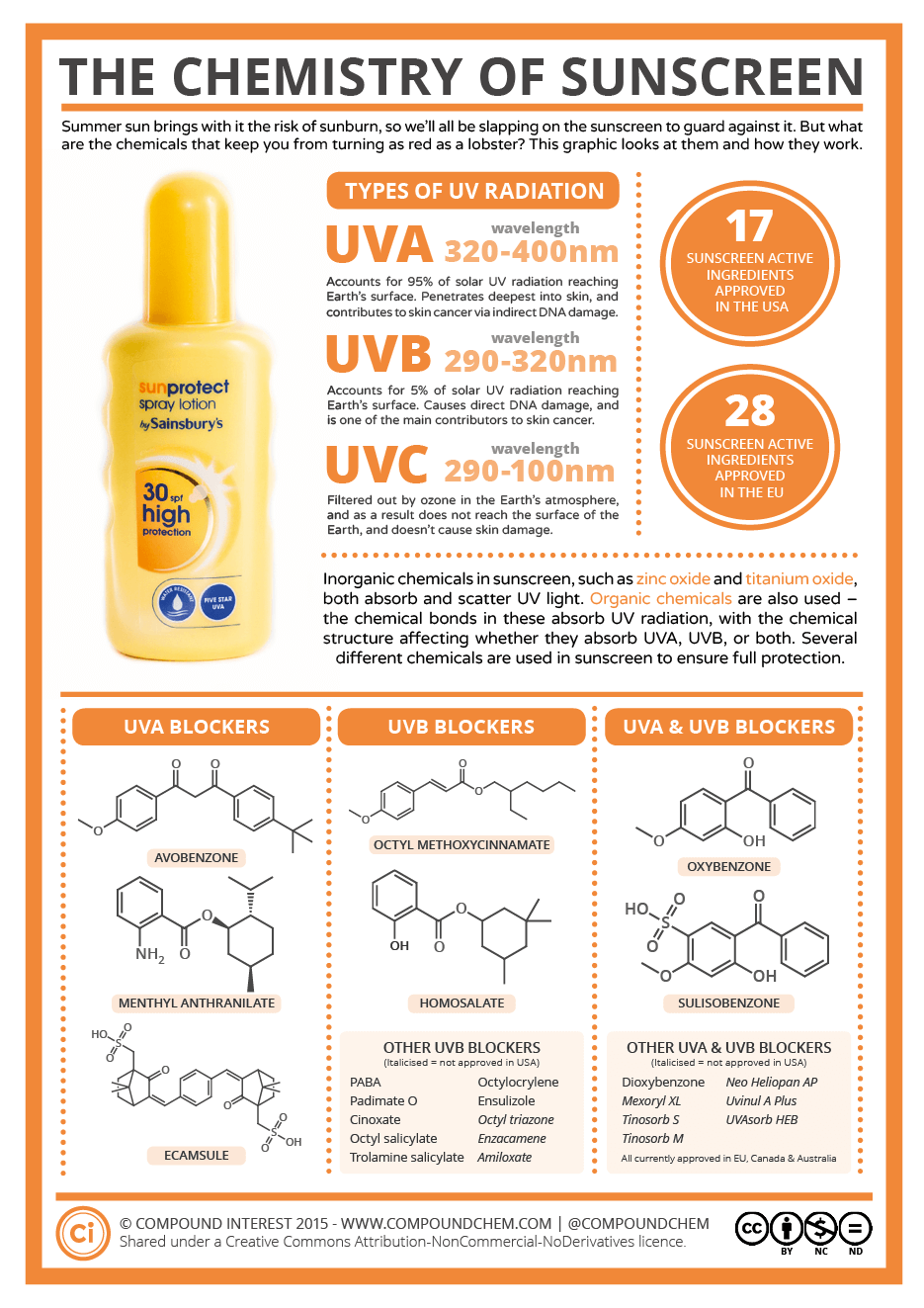6.3: Sunscreen
- Page ID
- 387427
Exposure to Ultraviolet Radiation
Of all the types of ionizing radiation, people come into more contact with ultraviolet radiation. Sources of this radiation would include the sun, ultraviolet lights, and tanning beds. The sun produces three different forms of ultraviolet rays (UVA, UVB and UVC). Fortunately, the deadliest of these three rays (UVC) never reaches the earth's surface and is absorbed by Earths' ozone layer. However, both UVA and UVB reach the Earth's surface to affect living systems.
UVA is produced naturally by the sun and artificially by lamps and tanning beds. For years, sunbathers believed that UVA provided only a youthful glow. Now, the American Academy of Dermatologists has condemned the use of tanning beds. Scientific research has correlated certain types of skin cancers (mainly basal and squamous cell) with the use of these devices. Besides skin cancer, tanning beds cause premature aging and damage to your eyes. If a tanning bed is not properly sanitized between uses, skin diseases can be transmitted from one consumer to another.
Sunblocks and Sunscreens
UVB radiation in sunlight allows the skin to produce vitamin D. This vitamin prevents bone disorders like rickets and osteoporosis (brittle bone disease). The American Academy of Dermatology suggests vitamin D be obtained through foods or nutritional supplements. Excessive exposure to UV can be damaging and the pigment melanin, deposited in cells at the base of the epidermis, helps to protect the underlying layers of the skin from this damage. Melanin also colors the skin and variations in the amount of melanin produces colors from pale yellow to black. The darker the skin tone, the more melanin one has, and the less likely skin cancer will occur.

Excess exposure to the sun can cause sunburn. This is common in humans, but light skinned animals like cats and pigs can also be sunburned, especially on the ears. Skin cancer can also result from excessive exposure to the sun. As holes in the ozone layer increase exposure to the sun’s UV rays, so too does the rate of skin cancer in humans and animals.
Sunscreens and sunblocks are designed to protect skin from ultraviolet rays. Sunblocks contain inorganic ingredients like zinc oxide or titanium dioxide. These chemicals act as UV filters by reflecting the sun's UV rays. Sunblocks can have grainy textures due to the inorganic components. The thick nature of a sunblock can make it difficult to spread evenly on the skin. Sunscreens contain organic compounds like oxybenzone, avobenzone, homosalate, and octinoxate (Figure \(\PageIndex{4}\)). By absorbing ultraviolet rays, these compounds decompose and give off heat. Sunscreens apply smoother than sunblocks. Often, manufacturers will combine sunscreen and sunblock ingredients to make their products.

Sun protection factor (SPF) measures a product's protection from UVB rays. SPF does not quantify protection from UVA radiation. The American Academy of Dermatology recommends you select a sunscreen or sunblock with a minimum SPF factor of 30. This SPF value means a lotion can filter out 97% of UVB rays. Moving to a SPF of 50 will only filter out 1 more percentage of UVB rays. Increasing a SPF factor past 30 really does very little in shielding skin from UVB radiation.
Products that protect skin from UVA must be labeled as being broad spectrum. Sunblocks provide UVA and UVB protection, but sunscreens can vary on what they can screen. Every two hours, sunscreens/sunblocks should be reapplied to the skin. Sweating and swimming can remove sunscreen/sunblock products. No sun products are waterproof, but some are labeled as being water resistant. Consumers are encouraged to reapply these products every two hours as well.
Contributors
- Template:ContribLawson
- Emma Gibney (Furman University)


